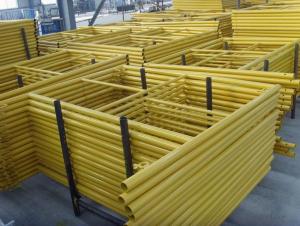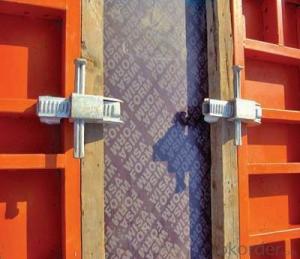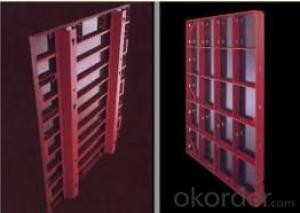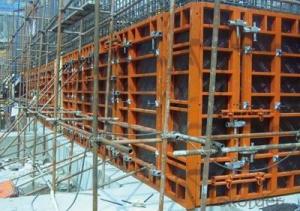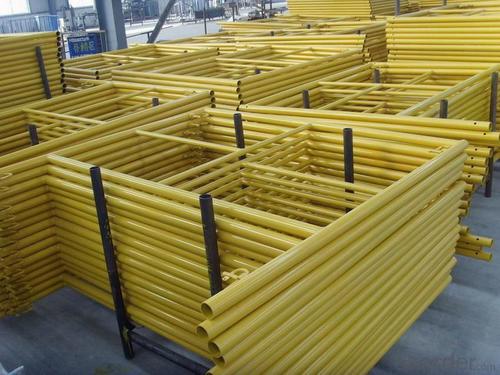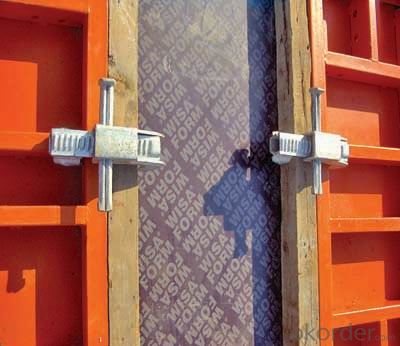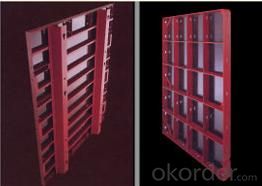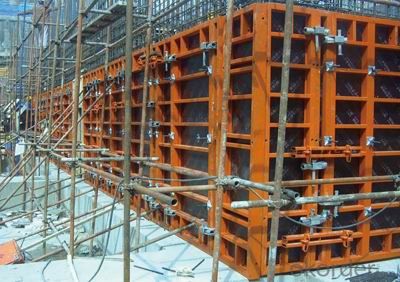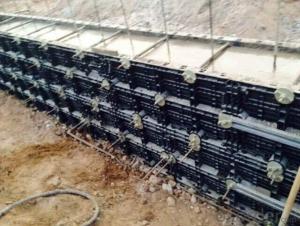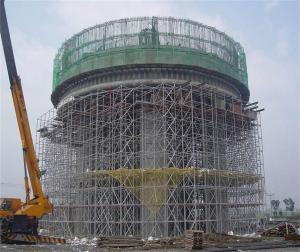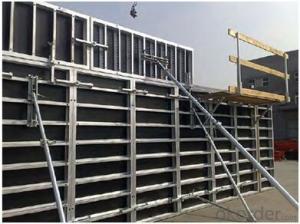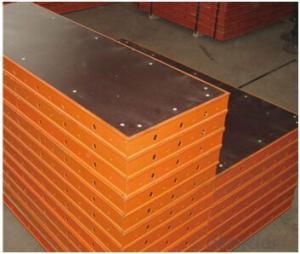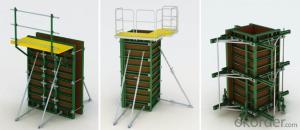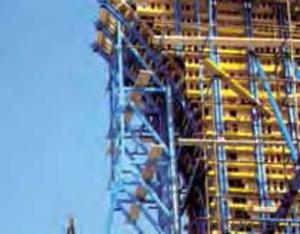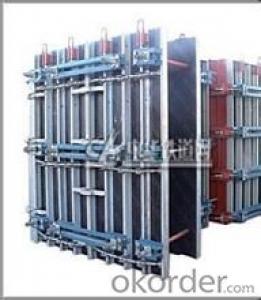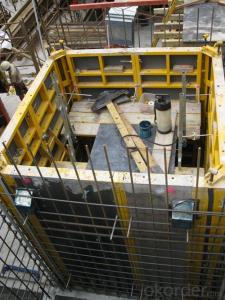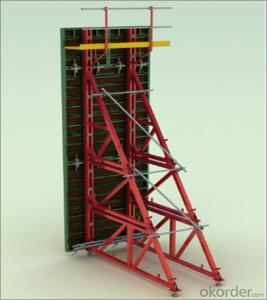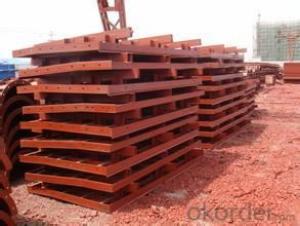Steel Frame Formwork with High Quality and Strong Strength in Construction
- Loading Port:
- Shanghai
- Payment Terms:
- TT OR LC
- Min Order Qty:
- 1 m²
- Supply Capability:
- 100000000 m²/month
OKorder Service Pledge
OKorder Financial Service
You Might Also Like
1. Structure of Steel Frame Formwork GK120
There is a prizing part designed in the corner, which can help to position and remove formwork easily.The plywood is screwed on from the back when connecting frame and plywood, so the surface of the finished concrete is perfect.The formwork series are a complete system with a full set of accessories, and can be set up flexibly according to project demand.
2. Main Features of Steel Frame Formwork GK120
High strength
High standardized system
Convenient for construction
Easy to control the quality
Easy, rapid and economical.
3. Steel Frame Formwork GK120 Images
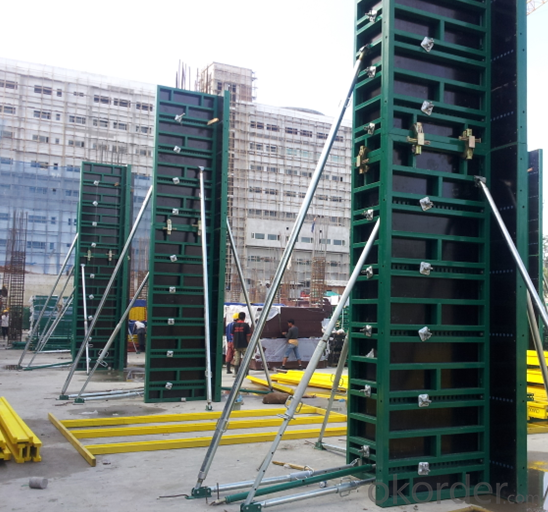
4. Steel Frame Formwork GK120 Specification
-Steel Frame Formwork GK120 is used for the concrete pouring of square or rectangle column. The system has the same structure and similar connection type with wall formwork.
-The frame is highly strengthened, and the wall formwork can bear lateral pressure 60 KN/m2 while the column formwork can bear 80 KN/m2.
-As a standardized system, it is flexible to assemble , wood batten can be filled to satisfy the need f of non-standard size.
-The adjustable steel clamp is convenient to use, and can hold tightly.
-The plywood is screwed on from the back when connecting frame and plywood, so the surface of the finished concrete is perfect.
5. FAQ of Steel Frame Formwork GK120
1) What can we do for you?
.We can ensure the quality of the vinyl banner and avoid extra expenses for customers.
.We can provide you the professional design team.
.We can provide fashionable and newest styles for you.
.We can design the artwork for you.
2) What promises can be done by us?
. If interested in Steel Frame Formwork GK120, please feel free to write us for any QUOTE.
. Please DO check goods when courier knocks your door and contact us asap if any issue.
3) What about of our after-sale service?
. Response will be carried out in 24hours after receiving any complain or request.
. Steel Frame Formwork GK120 cost can be refund after order is confirmed.
4) What about the package and shipping time?
.Packing: As Customer's Requirements
.Shipping: We have various shipping ways for our customers, such as express which including TNT, DHL, FEDEX, UPS, EMS, etc. ; by air/ sea, and we are VIP of these express.
.Shipping time:
Normally small orders, it just 10-15 business days to arrive your hand; When comes to the customs declaration, it may need 7 days.
- Q: Can steel frame formwork be used in projects with limited construction site lighting or visibility conditions?
- Steel frame formwork is suitable for projects with limited construction site lighting or visibility conditions. It offers a robust structure for pouring concrete and has excellent durability. It can handle heavy loads and is versatile for various construction projects. In situations where lighting or visibility is restricted, steel frame formwork can still be utilized efficiently by incorporating supplementary lighting sources like portable lighting equipment or construction site lighting towers. These lighting sources can be strategically positioned to ensure optimal visibility throughout the construction process. Moreover, steel frame formwork often incorporates practical features like color-coded components or marking systems that aid workers in assembling and disassembling the formwork, even in low-light conditions. Additionally, if necessary, the steel frame formwork can be enhanced with reflective materials or paint to enhance visibility and safety on the construction site. While limited construction site lighting or visibility conditions may present challenges, proper planning and the inclusion of additional lighting sources can guarantee the effective and safe application of steel frame formwork in such projects.
- Q: Can steel frame formwork be used for both cast-in-place and post-tensioned concrete construction?
- Yes, steel frame formwork can be used for both cast-in-place and post-tensioned concrete construction. Steel frame formwork is a versatile system that provides the necessary support and containment for poured concrete during construction. It consists of steel panels, adjustable props, and other accessories that can be assembled and disassembled easily to suit different construction needs. For cast-in-place concrete construction, steel frame formwork is commonly used to create the desired shape and dimensions of the concrete structure. The steel panels can be adjusted to form walls, columns, beams, and slabs, allowing for flexibility in design. The formwork system ensures that the concrete is poured and cured properly, resulting in a high-quality finished product. In post-tensioned concrete construction, steel frame formwork is also widely utilized. Post-tensioning is a technique where steel cables or tendons are tensioned after the concrete has been poured and cured. The steel frame formwork provides the necessary support and containment for the concrete during the tensioning process. It ensures that the tendons are properly positioned and protected while the concrete is being stressed. Overall, steel frame formwork is a suitable choice for both cast-in-place and post-tensioned concrete construction. Its versatility, strength, and adaptability make it a reliable system for creating various types of concrete structures.
- Q: What are the different types of formwork braces used in steel frame formwork systems?
- Steel frame formwork systems commonly utilize various types of formwork braces to provide stability and support during the pouring and curing of concrete. These braces play a crucial role in ensuring the integrity of the formwork. Here are several different types of formwork braces commonly used: 1. Adjustable Steel Braces: Made of steel, these braces offer adjustable length and are primarily utilized for horizontal support in the formwork system. Their adjustable feature enables flexibility in adapting to different formwork heights. 2. Push-Pull Props: Also known as shore props or acrow props, these telescopic tubular supports are employed to provide vertical support in the formwork. They can be easily adjusted to the desired height and are often used in conjunction with adjustable steel braces. 3. Strut Braces: Comprising steel tubes connected diagonally to the formwork system, strut braces deliver diagonal support and hinder lateral movement of the formwork. They prove particularly valuable in situations involving high wind loads or when additional support is required. 4. Cross Braces: Steel bars are utilized as cross braces to connect vertical formwork elements. They contribute to the lateral stability of the formwork system and help maintain the desired form and shape throughout the concrete pouring process. 5. Corner Braces: Designed specifically to support the corners of the formwork system, corner braces ensure stability and squareness during the concrete pouring and curing process. 6. Tension Rods: Tension rods reinforce the overall strength of the formwork system by providing additional support and stability. They are commonly used in conjunction with other braces, such as adjustable steel braces or strut braces. These represent some of the various types of formwork braces employed in steel frame formwork systems. The selection and combination of braces depend on factors including formwork size, complexity, load requirements, and environmental conditions at the construction site.
- Q: What are the common quality control measures for steel frame formwork systems?
- Some common quality control measures for steel frame formwork systems include regular inspection and maintenance of the formwork components, ensuring proper alignment and stability of the frames, conducting load testing to verify their strength and durability, monitoring the formwork installation process to ensure proper assembly and connection of the frames, and conducting regular checks on the concrete finish and dimensions achieved using the formwork system.
- Q: How does steel frame formwork help in ensuring accurate alignment of concrete elements?
- Steel frame formwork helps in ensuring accurate alignment of concrete elements by providing a sturdy and rigid structure that holds the formwork panels in place during the concrete pouring and curing process. The steel frame acts as a guide and support system, preventing any movement or displacement of the formwork panels, thus ensuring that the concrete elements are aligned precisely as per the design specifications. Additionally, the steel frame formwork allows for easy adjustments and modifications, enabling precise positioning of the formwork panels to achieve the desired alignment of the concrete elements.
- Q: How does steel frame formwork prevent the formation of concrete cracking during curing?
- Steel frame formwork helps prevent concrete cracking during curing by providing strong and rigid support to the structure. The steel frame acts as a mold and holds the concrete in place, ensuring that it maintains its desired shape and form during the curing process. The steel frame formwork also helps in evenly distributing the weight and pressure exerted by the wet concrete. This prevents the formation of concentrated stress points that can lead to cracking. The strong and stable nature of steel frame formwork effectively supports the weight of the concrete, reducing the risk of sagging or deformation. Furthermore, the steel frame formwork allows for controlled and uniform drying of the concrete. By preventing rapid drying or uneven moisture evaporation, it minimizes the potential for shrinkage cracks. The formwork also helps to retain moisture within the concrete, allowing for optimal curing conditions and reducing the risk of premature drying. Steel frame formwork offers excellent dimensional stability, which ensures that the concrete maintains its intended shape and size without significant distortion. This stability prevents the formation of cracks caused by uneven settling or movement of the concrete. Overall, steel frame formwork provides a robust and reliable support system that minimizes the risk of concrete cracking during curing. It ensures that the concrete remains strong, durable, and structurally sound, reducing the need for costly repairs or remedial work in the future.
- Q: What are the different types of formwork systems that can be used in conjunction with steel frame formwork?
- There are various formwork systems available that can be used alongside steel frame formwork. These include: 1. Timber formwork: Timber formwork is widely used and involves using timber boards or plywood to create the formwork structure. It is versatile, cost-effective, and easy to work with, making it suitable for a range of concrete structures such as walls, columns, beams, and slabs. 2. Aluminum formwork: Aluminum formwork is a lightweight and durable system consisting of interconnected aluminum panels. It is known for its high strength-to-weight ratio, allowing for faster construction and reduced labor costs. This type of formwork is commonly used for repetitive structures like residential buildings and commercial complexes. 3. Plastic formwork: Plastic formwork is gaining popularity due to its versatility and ease of use. It is made of lightweight and durable plastic panels that can be easily assembled and disassembled. Plastic formwork is suitable for various concrete structures, including walls, columns, and slabs. It offers advantages such as lower labor costs, reduced waste, and improved construction speed. 4. Fiberglass formwork: Fiberglass formwork is lightweight and strong, made of fiberglass panels capable of withstanding high concrete pressures. It is suitable for different concrete structures, including walls, columns, beams, and slabs. Fiberglass formwork offers benefits such as easy handling, reduced labor costs, and improved construction speed. 5. Modular formwork: Modular formwork involves using standardized components to create different formwork configurations. It can be integrated with steel frame formwork by combining the steel frames with the modular components. Modular formwork is highly flexible and adjustable to meet various construction requirements. It is suitable for complex structures and can be reused, making it cost-effective. In summary, these formwork systems offer advantages such as versatility, cost-effectiveness, ease of use, and increased construction speed. The choice of formwork system will depend on factors like project requirements, budget, and timeline.
- Q: How does steel frame formwork affect the overall aesthetics of a concrete finish?
- Steel frame formwork can significantly impact the overall aesthetics of a concrete finish. The use of steel frame formwork ensures superior quality and precision in the construction process, resulting in a smooth and flawless finish. The rigid steel frame acts as a support system, preventing any deformation or shifting during the pouring and curing stages of concrete. The steel frame formwork also provides a consistent and accurate formwork system, which allows for precise shaping and molding of the concrete structure. This enables architects and designers to achieve their desired aesthetic vision without any compromise. The straight lines, sharp edges, and smooth surfaces that can be achieved with steel frame formwork contribute to a visually appealing and modern appearance. Furthermore, steel frame formwork offers versatility and adaptability in design. It can be easily adjusted and customized to meet specific architectural requirements and desired finishes. Whether it is creating unique patterns, textures, or intricate designs, steel frame formwork provides the necessary flexibility to achieve the desired aesthetic outcome. In addition to aesthetics, steel frame formwork also enhances the durability and longevity of the concrete finish. The use of steel ensures structural integrity and strength, preventing any potential damage or deterioration over time. This means that the concrete finish will maintain its aesthetic appeal for a longer period, reducing the need for frequent maintenance or repairs. Overall, steel frame formwork plays a crucial role in shaping and enhancing the aesthetics of a concrete finish. It provides a solid foundation, precision, and versatility, allowing for the creation of visually pleasing and durable architectural designs.
- Q: What are the key considerations for selecting the appropriate steel frame formwork system for projects with unique architectural features?
- There are several important factors to take into account when choosing the right steel frame formwork system for projects with unique architectural features. These considerations guarantee that the system chosen can meet the project's specific requirements and demands, while also providing the necessary support and stability. 1. Flexibility and adaptability are crucial. The steel frame formwork system should be able to adapt to the project's unique architectural features. This means it should be adjustable to accommodate irregular shapes, curves, and intricate designs. The system should provide flexibility in terms of panel sizes, heights, and configurations to ensure a perfect fit for the project's needs. 2. Strength and durability are key. Projects with unique architectural features often require complex and challenging formwork structures. The chosen steel frame formwork system should be able to withstand the pressure and loads exerted by the concrete, ensuring stability and safety throughout the construction process. High-quality materials and construction techniques should be used to guarantee the system's strength and durability. 3. Assembly and disassembly should be made easy. Even with the project's unique architectural features, the formwork system should be relatively easy to assemble and disassemble. This will save time and resources during the construction process. The system should come with clear instructions and efficient connection mechanisms to facilitate quick and hassle-free installation. 4. Cost-effectiveness is important. Considering the project's unique architectural features, the selected steel frame formwork system should provide value for money. It should be cost-effective in terms of both initial investment and long-term maintenance. The system should be reusable and long-lasting, reducing the need for frequent replacements or repairs. 5. Safety and quality assurance are paramount. Safety is always a top priority in any construction project. The chosen steel frame formwork system should comply with relevant safety standards and regulations. It should also undergo rigorous quality assurance checks to ensure its reliability and performance. The system should be able to withstand the required loadings and provide a safe working environment for the construction workers. 6. Availability of technical support is essential. Projects with unique architectural features may require specialized technical support and expertise during the design and construction phases. The selected steel frame formwork system should be supported by a reputable manufacturer or supplier who can offer the necessary guidance and support throughout the project. This includes assistance in design calculations, formwork planning, and troubleshooting. In conclusion, choosing the right steel frame formwork system for projects with unique architectural features requires careful consideration of flexibility, strength, assembly ease, cost-effectiveness, safety, and technical support. By addressing these key factors, the chosen system can ensure the successful execution of the project while preserving the desired architectural features.
- Q: How does steel frame formwork contribute to the speed and efficiency of construction?
- Steel frame formwork contributes to the speed and efficiency of construction in several ways. Firstly, steel is a highly durable and strong material, allowing for the construction of robust formwork systems that can withstand the pressures and loads of the construction process. This durability ensures that the formwork can be reused for multiple projects, reducing the need for new formwork to be manufactured for each construction project. Additionally, steel frame formwork is highly adjustable and versatile, allowing for quick and efficient assembly and disassembly. The modular design of steel frame formwork enables it to be easily customized and adapted to various project requirements and dimensions. This adaptability reduces the time and effort required to set up the formwork, thereby speeding up the construction process. Moreover, steel frame formwork is lightweight, making it easier to handle and transport on the construction site. The lightweight nature of steel formwork reduces the need for heavy machinery, thus saving time and costs associated with machinery operations. Furthermore, steel frame formwork offers a smooth and even surface finish, resulting in high-quality concrete structures. This eliminates the need for additional finishing work, such as plastering or rendering, saving both time and resources. Lastly, steel frame formwork is highly resistant to moisture and weather conditions, ensuring its longevity and durability. This resistance reduces the need for constant maintenance and repairs, leading to increased efficiency and cost savings in the long run. In conclusion, steel frame formwork contributes to the speed and efficiency of construction through its durability, adaptability, lightweight nature, smooth surface finish, and resistance to moisture. These factors combine to reduce construction time and costs, ultimately enhancing the overall efficiency of the construction process.
Send your message to us
Steel Frame Formwork with High Quality and Strong Strength in Construction
- Loading Port:
- Shanghai
- Payment Terms:
- TT OR LC
- Min Order Qty:
- 1 m²
- Supply Capability:
- 100000000 m²/month
OKorder Service Pledge
OKorder Financial Service
Similar products
Hot products
Hot Searches
